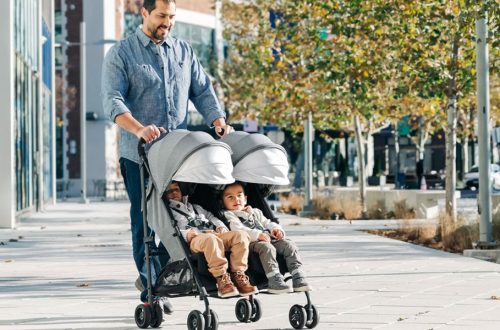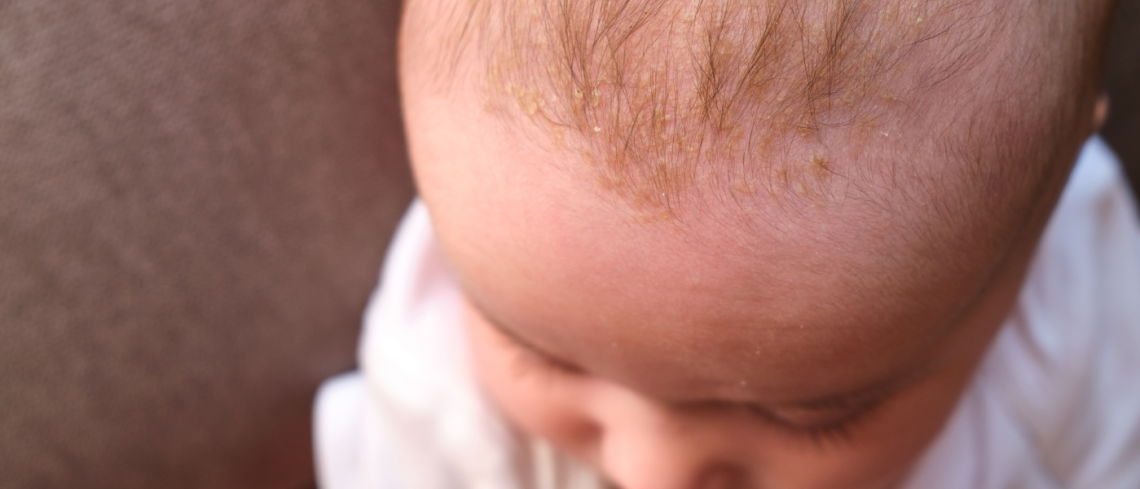
What is Cradle Cap? And How Do I Get Rid of It? – The Baby Cubby
I always thought that babies had the BEST skin. And although they do have the softest most beautiful skin, they are also prone to dermatological issues. Whether it be milia on the face, eczema on their arms or legs, or cradle cap on their noggins, it’s inevitable that your baby will develop at least one skin condition in the first few months of life (if not several). For my son, it was cradle cap. And although it didn’t bother him, it deeply bothered me. So today, let’s take a look at the basics of cradle cap–from what it is and what causes it, to how to get rid of it. Because if you’re like me, it’s hard to let things be, especially when they’re affecting our babies!
What is Cradle Cap?
Cradle cap is a type of seborrheic dermatitis that often effects newborns and young infants. It is caused by overactive sebaceous glands that cause overproduction of sebum (or oil). Normally, this occurs on the top of your baby’s scalp, but it can also occur on the neck and face, as well as body folds like behind the knees and elbows (although these are less common).
Cradle cap is pretty easy to diagnose, as the symptoms are pretty apparent and distinct from other skin conditions. Most commonly, infants with cradle cap will have dry patches of skin across the top of their head that appear crusty or scaly. And although it will be dry and flaky, the skin will also be greasier than normal.
The skin flakes can range in color from white to yellow, and patches can be small and limited to certain areas of the head, or widespread and thick, spanning the entire skull (shown below). Your baby may also have some redness of the skin in the effected areas. And although the condition may look bad, it does not usually cause your child itchiness or pain.
Normally, cradle cap can be treated at home very easily, and no medical attention or prescriptions are needed. It’s also important to note that cradle cap is not infectious or transmissible, so you don’t need to worry about your other children getting it.
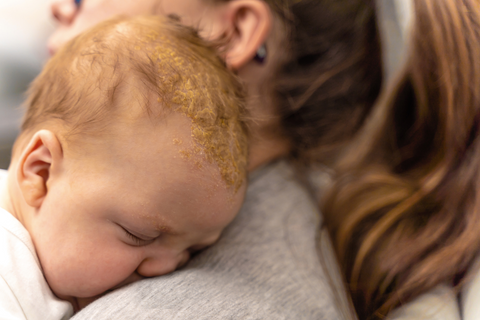
Is Cradle Cap Common?
Yes! Cradle cap is extremely common! In fact, studies show that in the newborn stage, prevalence is around 10%. Once you hit 3 months, though, prevalence rises to a whopping 70%! That means that if you took a random sample of 3-month-old babies at any given time, 7 out of 10 would be showing signs of cradle cap. Of those, some will exhibit a severe case with extreme scaling, while others will only develop minor dryness or flaking. Either way, it is extremely likely your child will have some level of dry and scaly skin in the first few months of life.
What Causes Cradle Cap?
Researchers don’t know for sure what causes cradle cap. However, several hypotheses exist. The first is that baby’s still have lingering hormones from their mother circulating within their system from when they were in the womb. This prevalence of hormones within the infant may lead to overactivity of the baby’s sebaceous glands, leading to an oily scalp. Normally, dead skin cells fall off without notice. But when the skull is extremely oily, this prevents those cells from falling off, and it builds up and leads to scaly and crusty skin.
Another theory includes the influence of Malassezia yeasts in the development of cradle cap. These yeasts feed on sebum, but only consume the fatty acid portion while leaving behind the unsaturated portion that leads to the development of cradle cap. Studies found that about 80% of those with cradle cap also had prevalence of the yeast. However, more research needs to be done to show a more linear causality.
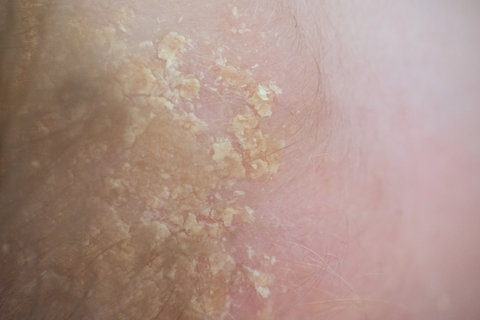
How Long Does Cradle Cap Last?
Unfortunately, cradle cap can last for several months. Our babies’ bodies are trying to adjust to their new world. And it can take time for their glands to figure out how much oil to produce and for their systems to normalize.
Normally, cradle cap will go away on its own within 4-6 months, but it can take as long as a year for it to fully go away, especially in severe cases. In minor cases, it can resolve in a few weeks/months. Luckily, there are some things you can do to gently encourage the cradle cap to go away, but you must be patient and avoid resorting to methods that may actually make matters worse or hurt your baby.
How Do I Get Rid of Cradle Cap?
Although cradle cap cannot be resolved in a matter of hours or days, there ARE some things we can do to help decrease the severity of it and improve the appearance of your baby’s skin.
When caring for your baby’s cradle capped head, it’s important to always be GENTLE, and never do anything that could cause harm or scarring to your baby. It can be difficult not to pick at the dry scales, but doing this can cause severe long-term damage as well as pain to your baby.
When my son was a few months old and had cradle cap, leaving the scales untouched felt impossible for me. It looked horrible, and I figured it wouldn’t be a big deal to just pick the scales off if I was gentle. I noticed, however, that when I did this, my son acted uncomfortable, and I realized I was probably causing him pain (even though I felt like I was being gentle). Doing this can also lead to bleeding and even scarring on your baby’s head, so do NOT pick at the dry patches on your baby’s skin, even if you think it will help! If you can’t resist picking, put a hat on them so that you’re not tempted to pick. Just don’t leave the hat on all day long, as the fresh air and freedom can encourage healing.
Instead, implement a gentle, daily routine, that includes the following:
A warm bath daily, letting the water sit on baby’s head and naturally loosen the scales.
Frequent washing of baby’s head with a sensitive baby shampoo. Fragrance-free shampoos are a great option, as some fragrances can irritate the scalp more. For severe cases, switch to a shampoo that is specifically designed to deal with cradle cap (consult a dermatologist first for baby-safe recommendations).
A gentle head massage with a soft bristle toothbrush, baby comb, or infant hairbrush after bath time or whenever flaking is bad. (This bamboo brush from Kyte baby is a MUST!) Remember, do not scratch aggressively.
If your baby’s cradle cap is extremely dry, applying a baby oil to the scalp an hour before their bath can help soften those scales, making it easier to remove them during bath time. However, do NOT apply lotions or oils after their bath, as this will likely make cradle cap worse. (Remember, cradle cap is produced by an overproduction of oils, so leaving oils or lotions on 24/7 will just make their head even more oily.)
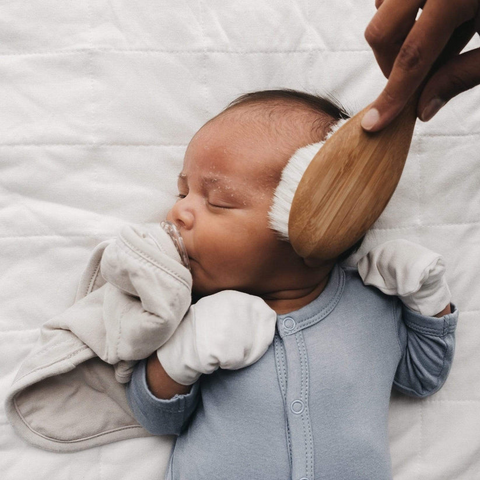
Kyte Baby Bamboo Cradle Cap Brush
Can You Prevent Cradle Cap?
Unfortunately, there’s nothing you can really do to prevent cradle cap altogether. It’s not caused by poor hygiene, so even if you do the best you can to keep your baby’s head clean, they may still develop it. If and when they do, just do your best to continue to keep the area clean, and it will resolve itself in due time.
What’s The Difference Between Cradle Cap and Eczema?
Cradle cap and eczema are both dermatological conditions, and if you’re not familiar with either, you may not know how to tell the difference. Both conditions can lead to dry skin. However, cradle cap is primarily found on an infant’s scalp and will cause more greasy or oily patches. It also normally resolves itself in a few months, and it doesn’t cause discomfort.
Eczema (atopic dermatitis), on the other hand, is normally found on the arms, legs, and behind the joints (although it can be found anywhere on the body.) It will look much more dry, and it won’t be oily like cradle cap.
Eczema also effects those of all ages and can cause pain, discomfort and itchiness. Eczema will go away as you keep it hydrated, although, for those prone to developing it, it will likely come back. So using good, hydrating lotions on a daily basis can be beneficial. It’s also important to avoid scratching or itching, as this can make it worse.
Like cradle cap, eczema is not contagious, but some babies may be more prone to developing it than some people just because of the way your body is.
When Should I See a Doctor?
Most cases of cradle cap are not worrisome, and most doctors will just recommend that you keep the area clean and give it time to heal on its own. However, if it doesn’t resolve itself by the time your child turns one, you observe severe redness or odor, or your child seems uncomfortable or in pain, make an appointment with a dermatologist or your child’s pediatrician.
Our babies are so precious! And so is their skin! But even if we do everything we can to keep their skin clean, soft, and beautiful, they still may develop dermatological issues. But being educated on what to expect and how best to resolve them can make these problems much less of a burden–for your baby AND for you!
For more information on infant health and wellness, be sure to visit our blog at babycubby.com!



